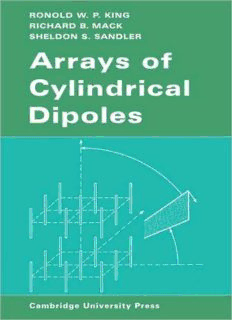
Arrays of Cylindrical Dipoles PDF
Preview Arrays of Cylindrical Dipoles
ARRAYS OF CYLINDRICAL DIPOLES ARRAYS OF CYLINDRICAL DIPOLES RONOLD W. P. KING Gordon McKay Professor of Applied Physics Harvard University RICHARD B. MACK Research Physicist Air Force Cambridge Research Laboratories SHELDON S. SANDLER Associate Professor of Electrical Engineering Northeastern University Research Fellow, Harvard University CAMBRIDGE AT THE UNIVERSITY PRESS 1968 CAMBRIDGE UNIVERSITY PRESS Cambridge, New York, Melbourne, Madrid, Cape Town, Singapore, Sao Paulo, Delhi Cambridge University Press The Edinburgh Building, Cambridge CB2 8RU, UK Published in the United States of America by Cambridge University Press, New York www.cambridge.org Information on this title: www.cambridge.org/9780521114851 © Cambridge University Press 1968 This publication is in copyright. Subject to statutory exception and to the provisions of relevant collective licensing agreements, no reproduction of any part may take place without the written permission of Cambridge University Press. First published 1968 This digitally printed version 2009 A catalogue record for this publication is available from the British Library Library of Congress Catalogue Card Number: 67-26069 ISBN 978-0-521-05887-2 hardback ISBN 978-0-521-11485-1 paperback To Tai Tsun Wu Good reasons must, of force, give place to better. Shakespeare CONTENTS page Preface xi CHAPTER 1. INTRODUCTION 1 1.1 Fundamentals—field vectors and potential functions 1 1.2 Power and the Poynting vector 9 1.3 The field of the electrically short antenna; directivity 11 1.4 The field of antennas with sinusoidally distributed currents; radiation resistance 14 1.5 The field of a two-element array 16 1.6 Fields of arrays of N elements; array factor 19 1.7 Impedance of antenna; EMF method 22 1.8 Coupled antennas; self- and mutual impedances 29 1.9 Radiation-pattern synthesis 32 1.10 The circular array 40 1.11 Limitations of conventional array theory 44 CHAPTER 2. AN APPROXIMATE ANALYSIS OF THE CYLINDRICAL ANTENNA 46 2.1 The sinusoidal current 46 2.2 The equation for the current 47 2.3 Properties of integrals 49 2.4 Rearranged equation for the current 51 2.5 Reduction of integral equation to algebraic equation 52 2.6 Evaluation of coefficients 54 2.7 The approximate current and admittance 55 2.8 Numerical examples; comparison with experiment 56 2.9 The radiation field 58 2.10 An approximate two-term theory 63 2.11 The receiving antenna 65 Vlll CONTENTS CHAPTER 3. THE TWO-ELEMENT ARRAY 70 3.1 The method of symmetrical components 70 3.2 Properties of the integrals 73 3.3 Reduction of integral equations for phase sequences to algebraic equations 75 3.4 The phase-sequence currents and admittances 78 3.5 Currents for arbitrarily driven antennas; self- and mutual admittances and impedances 80 3.6 Currents for one driven, one parasitic antenna 82 3.7 The couplet 83 3.8 Field patterns 84 3.9 The two-term approximation 85 CHAPTER 4. THE CIRCULAR ARRAY 95 4.1 Integral equations for the sequence currents 97 4.2 Sequence functions and array properties 103 4.3 Self- and mutual admittances 105 4.4 Currents and fields; arrays with one driven element 112 4.5 Matrix notation and the method of symmetrical com- ponents 121 4.6 General formulation and solution 125 CHAPTER 5. THE CIRCUIT AND RADIATING PROPERTIES OF CURTAIN ARRAYS 130 5.1 General comparison of conventional and new theories 130 5.2 New theory of curtain arrays 133 5.3 Examples 143 5.4 Electronically scanned arrays 150 5.5 Examples of the general theory for large arrays 158 5.6 The special case when fth = n/2 171 o 5.7 Design of curtain arrays 173 5.8 Summary 179 CONTENTS IX CHAPTER 6. ARRAYS WITH UNEQUAL ELEMENTS; PARASITIC AND LOG-PERIODIC ANTENNAS 181 6.1 Application of the two-term theory to a simple parasitic array 181 6.2 The problem of arrays with parasitic elements of un- equal lengths 188 6.3 Application to the Yagi-Uda array 191 6.4 Evaluation of coefficients for the Yagi-Uda array 195 6.5 Arrays with half-wave elements 198 6.6 The far field of the Yagi-Uda array; gain 201 6.7 Simple applications of the modified theory; compari- son with experiment 207 6.8 The three-element Yagi-Uda array 215 6.9 The four, eight and ten director Yagi-Uda array 218 6.10 Receiving arrays 232 6.11 Driven arrays of elements that differ greatly in length 237 6.12 The log-periodic dipole array 244 6.13 Analysis of the log-periodic dipole array 247 6.14 Characteristics of a typical log-periodic dipole array 251 6.15 Frequency-independent properties of the log-periodic dipole array 258 6.16 Experimental verification of the theory for arrays of unequal dipoles 269 CHAPTER 7. PLANAR AND THREE-DIMENSIONAL ARRAYS 272 7.1 Vector potential and integral equations for the currents 273 7.2 Vector potential differences and integral equations 277 7.3 Approximate distribution of current 278 7.4 Evaluation of coefficients 280 7.5 The field patterns 283 7.6 The general two-element array 286 7.7 A simple planar array 293
Description: